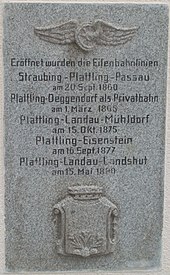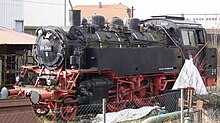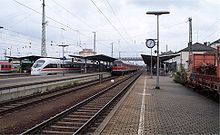Plattling train station
| Plattling | |
|---|---|
|
Reception building street side, 2008
|
|
| Data | |
| Location in the network | Crossing station |
| Platform tracks | 7th |
| abbreviation | NPL |
| IBNR | 8000301 |
| Price range | 3 |
| opening | September 20, 1860 |
| Profile on Bahnhof.de | Plattling |
| location | |
| City / municipality | Plattling |
| country | Bavaria |
| Country | Germany |
| Coordinates | 48 ° 46 '49 " N , 12 ° 51' 49" E |
| Height ( SO ) | 323 m above sea level NHN |
| Railway lines | |
|
|
| Railway stations in Bavaria | |
The Plattling Train Station is a central railroad junction in the eastern Lower Bavaria .
history
The first station building near the city was built for the Plattling train station and opened on September 20, 1860 with the start of operations on the Straubing - Passau eastern line . From 1866 to 1877, the Deggendorf-Plattlinger Eisenbahn AG freight railway ended at the freight station to the west . During the construction of the forest railway line via Zwiesel to Bayerisch Eisenstein for the purpose of importing Bohemian coal to Tyrol from 1874, the passenger station was moved to the west due to the confluence of this line and it was rebuilt at its current location, 500 m at the height of the freight station. On October 15, 1875, Plattling received another rail connection, this time to the south via Pilsting to Mühldorf ( Mühldorf – Pilsting line ), which was supplemented in 1880 by a branch line to Landshut .
On April 16, 1945, the entire station was destroyed in a bomb attack lasting only seven minutes. The Plattling station building, which was also completely destroyed in this bombardment, was rebuilt in the same place after the war.
Two plant connections became more important in Plattling: Südzucker AG has had a large plant on the route to Deggendorf since 1960/61 in order to save transport routes. From the 1961 season onwards, beet trains rolled here from the Gäuboden and ensured the survival of many branch lines. On October 31, 1976, the Plattling station was blocked with 1200 cars. Although these transports relieved the roads, the DB stopped these transports in 1988 due to the unprofitable wagon provision. Since then, only finished products have been loaded from the sugar factory. There is also a connection network of almost 4 km in length, into which the railway delivers or picks up cars. In 1982 the paper mill was built one kilometer north of the train station. This had its own work locomotive 322 154 , since 1987 replaced by a Henschel DH 500 . This was handed over in 2002 and the DB took over the delivery and shunting tasks for the often 5000 wagons of beatings that are delivered annually.
With the opening of electrical operations on the Regensburg – Passau main line in May 1959 and the general change of traction at the DB, the Plattling depot soon lost its duties in the maintenance of steam locomotives. The last train hauled by a steam locomotive drove from Plattling to the Bavarian Forest on March 6, 1974 . In order to preserve the historical roundhouse, which is supposed to be in danger of collapsing, the company Michael Hacker took over with the help of the newly founded Historisches Eisenbahnverein Plattling e. V. (HEV) used this locomotive hall as a warehouse in 1986. Soon afterwards, Michael Hacker commissioned the expansion and scrapping of the turntable. As a reminder of the city's great railway times, the HEV had set up the steam locomotive 64 344, which had previously been stationed in Plattling, in the loading yard on the station premises from January 1988, but was handed over to the Passauer Eisenbahnfreunde (PEF) for processing in Passau on November 7, 2009 . In the night of June 2nd to 3rd, 2008, the entire 4300 square meter locomotive shed, in which around 1000 tons of paper rolls and around 6000 pallets with wooden briquettes were stored, burned down to the foundation walls.
Depot
When the station was rebuilt in 1877, a locomotive depot with twelve stalls, a wagon workshop, locomotive treatment systems and a gas station were set up. The goods shed was built to the west of the reception building.
At the turn of the century, the facilities were too small. In the spring of 1900, a roundhouse was built with 28 stalls and an 18-meter turntable. A second circular shed followed in 1903, initially with ten stands, which were expanded to twenty stands in 1929 and were given a 20 m turntable. In 1924 a larger coaling plant followed, which replaced the old basket coaling.
While the express trains passing Plattling were hauled by the Regensburg depot, Plattling was home to work locomotives for passenger trains, freight train and shunting services as well as local rail traffic . Up until the First World War , only locomotives from the Bavarian State Railroad were available, which had replaced machines from the Eastern Railway at the turn of the century. New locomotives of the G 3/4 H and R 3/3 were delivered directly to Plattling. Prussian locomotive types were seen here for the first time in 1928 with the T 9.3 . The allocation of six standard passenger locomotives of the class 24 (BR 24), which were particularly suitable for the forest railway with 15 t axle mass, was recorded as real progress . In 1933 all nine 24er in Lower Bavaria were based in Plattling.
The first railcars, VT 135 012 and 013 , arrived in 1933. In September 1939, Plattling received ten brand-new freight train steam locomotives with a tender of the class 50 , which remained here until the end of the steam locomotive era. In 1943/44 the BR 24 was successively handed over to the Graudenz depot and replaced by the first freight train tender locomotives of the 86 series .
On April 1, 1941, 420 men were working at this office, which were needed for around 70 locomotives.
During the air raid on April 16, 1945, 45 steam locomotives and 1,458 wagons were destroyed.
After the war, Plattling received BR 64 passenger train tank locomotives and other BR 86 locomotives, which also served the branch lines in the Bavarian Forest. In 1953 the first rail buses rolled out. From 1962 on, Plattling was given diesel locomotives . The proven 50s formed the backbone of the Plattlinger work fleet until 1974. After the 50 3063 (053 063-4) had carried the last passenger train to Bayerisch Eisenstein with the N 2964 on March 6, 1974 and the counter train N 2967 the following day, the Plattling depot was "steam-free".
On May 31, 1985, this site was closed and after a few events in the empty buildings, it was demolished.
The locomotive stations in Arnstorf , Bodenmais , Eging , Bayerisch Eisenstein, Kröhstorf , Regen and Zwiesel acted as branch offices.
Current situation
Seven tracks are used for passenger traffic. There is a ticket office in the reception building as well as a café and a newsagents shop. The station has been barrier-free since November 2010 .
The Plattling train station is now the central traffic hub in eastern Lower Bavaria. Trains from all four directions arrive at the station shortly before the hour.
- Long-distance and regional trains run on the double-track electrified east-west main line Regensburg – Passau (KBS 880). Since December 2007 ICE trains from Frankfurt to Vienna every two hours, and occasionally IC trains. In addition, there is a brisk freight traffic, especially with Austria .
- On the single-track electrified southern section of Landshut and Munich are (KBS 931) Danube Isar-Express called since December 2009, regional express trains from Passau to Munich every hour on the road. Before that, there was an hourly change between regional trains that were broken in Plattling and regional express trains running through. In freight transport, it is mainly trains to and from the BMW plant in Dingolfing .
- On the single-track, non-electrified northern line to Bayerisch Eisenstein, the railcars of the Waldbahn run every hour, which are driven by the Regentalbahn .
| Train type | route | Clock frequency |
|---|---|---|
| ICE 91 | ( Dortmund - Cologne - Koblenz -) Frankfurt - Würzburg - Nuremberg - Regensburg - Plattling - Passau - Vienna | Every 2 hours |
| IC 31 | ( Fehmarn-Burg / Kiel -) Hamburg - Bremen - Dortmund - Cologne - Koblenz - Frankfurt - Nuremberg - Regensburg - Straubing - Plattling - Passau | Individual trains |
| RE |
Donau-Isar-Express Munich Hbf - Freising - Landshut - Plattling - Passau |
Hourly |
| ag | Neumarkt (Upper Palatinate) - Parsberg - Regensburg - Straubing - Plattling | Hourly |
| WBA |
Forest railway (brand) Plattling - Deggendorf - Zwiesel - Bayerisch Eisenstein (- Špičák) |
Hourly |
Web links
- Live webcam from the Plattling train station.
- Bf Plattling in the Bayern station database (BEG)
- Historic Railway Association Plattling e. V. (HEV)
literature
- Walther Zeitler: Railways in Lower Bavaria and Upper Palatinate . 2nd edition, Amberg 1997.
- Wolfgang Klee, Ludwig v. Welser: Bayern Report, Volumes 1–5. Fürstenfeldbruck 1993–1995.
- Siegfried Bufe: Railway station for the Bavarian Forest . In: Eisenbahngeschichte 49, ISSN 1611-6283 , pp. 4–15.
- Bernhard Rückschloß: The Plattling train station. 150 years of the railway in the center of Lower Bavaria. Ed .: Modell-Eisenbahn-Verein Deggendorf eV Verlag Heinz Ebner, Deggendorf 2010, ISBN 978-3-934726-48-2 .
Individual evidence
- ↑ Query of the course book route 880 at Deutsche Bahn.
- ↑ a b Query of the course book route 931 at Deutsche Bahn.
- ↑ Query of the course book route 905 at Deutsche Bahn.
- ↑ Literature Bufe, pp. 5–7
- ^ Bernhard Rückschloß: The Plattling station. 150 years of the railway in the center of Lower Bavaria. Ed .: Modell-Eisenbahn-Verein Deggendorf eV Verlag Heinz Ebner, Deggendorf 2010, ISBN 978-3-934726-48-2 .
- ↑ Literature Bufe, p. 15
- ↑ Welt Online Historic Plattling engine shed destroyed
- ^ Locomotive shed Plattling
- ↑ Literature Bufe, pp. 5–14
- ↑ The barrier-free station is inaugurated on May 17th, 2011. Bavarian Railway Company, accessed on July 28, 2010 .




